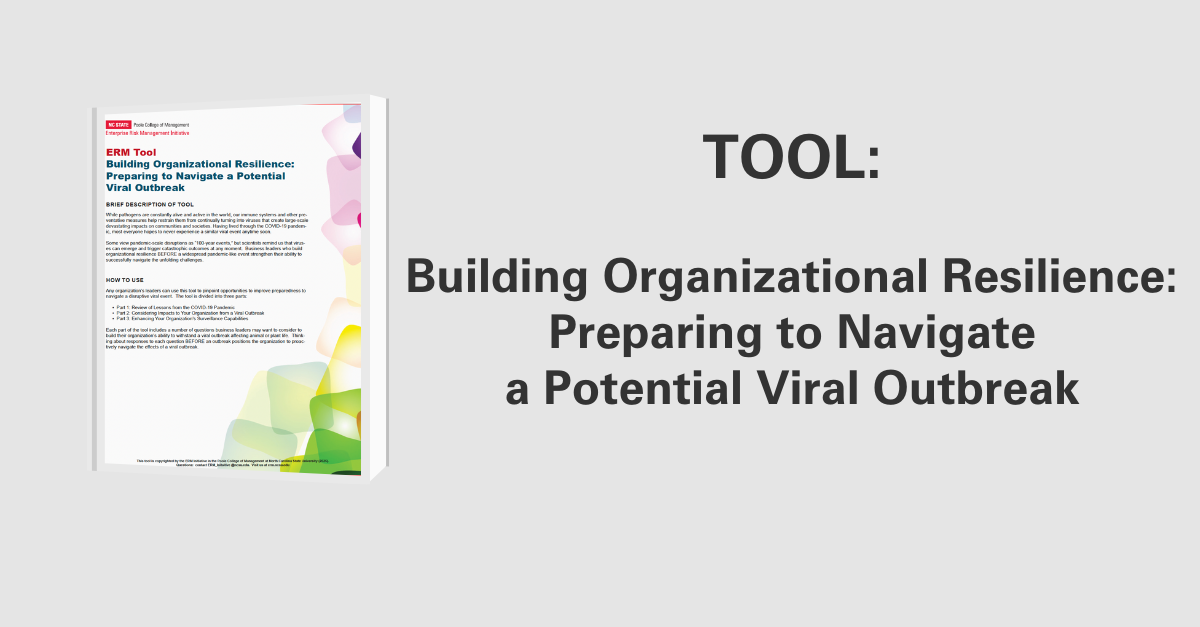A Global Outlook: 2019 Risk Report
In the 2019 Global Risk Report developed by World Economic Forum, responses from the Global Risk Perception Survey fell into five themes: (1) economic vulnerabilities, (2) geopolitical tensions, (3) societal and political strains, (4) environmental fragilities, and (5) technological instabilities. In addition to these five themes, the report discusses the evolving risks in a multi-conceptual world and the human side of global risks. Additionally, there is a look into the transformation of biological risks, how to prepare for rising sea-levels, and a future shock scenario.
2019 Global Risk Report
Economic Vulnerabilities
During 2018, economic vulnerabilities became a focal point of discussion as volatility in the financial markets increased, the rate of global growth seems to have peaked, the global debt has skyrocketed to 225% of GDP, and global financial conditions continue to tighten. With nine risks identified, and listed below, this theme was the most mentioned by respondents.
- Asset bubbles in a major economy
- Deflation in a major economy
- Failure of a major financial mechanism or institution
- Failure/shortfall of critical infrastructure
- Fiscal crises in key economies
- High structural unemployment or underemployment
- Illicit trade
- Severe energy price shock
- Unmanageable inflation
Geopolitical Tensions
Both geopolitical and geo-economic tensions are emerging between the world’s major powers, representing the most urgent global risks at this point in time. As the era of globalization ends, we are entering a new period where relations between deeply integrated countries are being reconfigured. To highlight the risks of such realignment, during 2018, trade and investment relations among major powers were significantly strained. The following describes the geopolitical risks identified by those surveyed in the Global Risk Perception Survey.
- Failure of national governance
- Failure of regional or global governance
- Interstate conflict with regional consequences
- Large-scale terrorist attacks
- State collapse or crisis
- Weapons of mass destruction
Societal and Political Strains
Increasing polarization of societies was ranked by respondents as the second most significant driver of developments in the global risks landscape. With 85% of respondents expecting major-power political confrontations and 59% of respondents expecting risks associated with public anger against elites, it is clear that cohesion among societies may be a key determinant of whether countries will be able to anticipate or respond to societal challenges. Respondents identified six broad and distinctly paramount societal and political risks they expect to see.
- Failure of urban planning
- Food crises
- Large-scale involuntary migration
- Profound social instability
- Rapid and massive spread of infectious diseases
- Water crises
Environmental Fragilities
As biodiversity loss continues to accelerate and extreme weather events are occurring more frequently, environmental risks rightfully dominated the top global risks of 2019 in both likelihood and impact categories.
- Extreme weather events
- Failure of climate-change mitigation and adaptation
- Major biodiversity loss and ecosystem collapse
- Major natural disasters
- Man-made environmental damage and disasters
Technological Instabilities
As technological innovation continues to change the ways in which we live, respondents noted that there are several major technological vulnerabilities to consider. While cyber-attacks and the threat of data fraud and theft remain key risks today, over half of respondents believe risks associated with fake news, identity theft, and loss of privacy will increase in 2019.
- Adverse consequences of technological advances
- Breakdown of critical information infrastructure and networks
- Large-scale cyber attacks
- Massive incident of data fraud/theft
Evolving Risks in a Multi-Conceptual World
Global power is now being dispersed among what were once minor global players and there is more room for diverging norms and values to affect global politics and the global economy. With this alteration in global order, there are three trends with the ability to trigger disruptive change:
- The difficulty of sustaining global consensus on ethically charged issues,
- Intensifying pressure on multilateralism and dispute-settlement mechanisms, and
- States’ increasingly frequent use of geo-economic policy interventions.
The Human Side of Global Risks
The Global Risk Report covers many tangible issues that are easily seen and identified. What is often left to the wayside is the impact on human mentality. When considering how global risks will impact the future, it is paramount to evaluate the human costs of psychological and emotional strain. Psychological and emotional well-being is reportedly declining, with anger, fear and anxiety increasing and a marked decrease in empathy for others. These trends are showing up in three areas: societal, technological and work-related.
Societal
As a society, we are experiencing an increase in negative experiences, most commonly arising as anger, pain, and stress. For example, opposing political groups previously expressed frustration with each other and now they express fear and anger. From a mental health perspective, depression and anxiety disorders increased by 54% and 42%, respectively, between 1990 and 2013. Although the decreased stigmatization around and increased availability of assistance for mental disorders is likely to have contributed to these statistics, there is evidence that the diagnosis of mental disorders has increased in younger population, especially for individuals between the ages of 12 and 17.
Technological
There is much controversy over the impact of technology on the human mentality. On one side, studies suggests that technology may cause loneliness, social isolation, increased mental health issues, a lack of empathy, and addiction tendencies. In contrast, people believe that technology makes it easier to connect with others and any negative effects are minimal.
Workplace
Affected by both societal and technological changes is the place in which we work. Current trends depict a workforce that is rarely enthusiastic about their work, minimally engaged at work, and often exhausted due to work. Additional stressors identified include the decline in job security, job stability, and a work-life balance.
The Transformation of Biological Risks
Global transformations have increased the risk of devastating outbreaks and manufactured, weaponized biological threats. Although technological innovation has the potential to mitigate these risks, the world is largely unprepared for such risks to come to fruition. If action is not taken to manage these risks, an outbreak could have a drastic impact on individual lives, societal well-being, economic activity and national security.
Preparing for Sea-Level Rise
With two-thirds of the global population expected to live in cities by 2050, 800 million people currently living in coastal cities, and a forecasted rise of sea-level of 0.5 meters by 2050, more and more people will be vulnerable to damage, disruption and, more than likely, poverty. Main strategies for adapting to rising sea-levels include engineering projects to keep water out, nature-based defenses, and people-based strategies, such as relocating houses and buildings to safer ground or investing in resilient infrastructure.
Future Shock Scenarios
Future shock scenarios are those in which nominally small events occur and trigger a cascade of other risk events at a rapid pace to result in a severe crisis. Such scenarios are helpful in that they remind us that risk can be unexpected and respond in creative ways. One example of a future shock is a scenario in which the distance between urban and rural areas reaches a tipping point where socio-economic differences are blatant. Attributes such as values, age, education, power and prosperity differ vastly between those living in urban areas and those living in the rural areas.
Summary
In conclusion the 2019 Global Risk Report identifies and describes five risk themes: economic vulnerabilities, geopolitical tensions, societal and political strains, environmental fragilities, and technological instabilities. The report discusses the how the diffusion of global power is affecting global risk and the human mental costs of these global risks. A look into the transformation of biological risks reveals the danger of being underprepared for outbreaks and weaponized biological instruments. Lastly, strategies to mitigate the risks related to rising sea-levels are identified, and a future shock scenario describes how urban versus rural living diverges into two separate societies.
Original Article Source: “The Global Risks Report 2019,” World Economic Forum, 2019
- Types:


